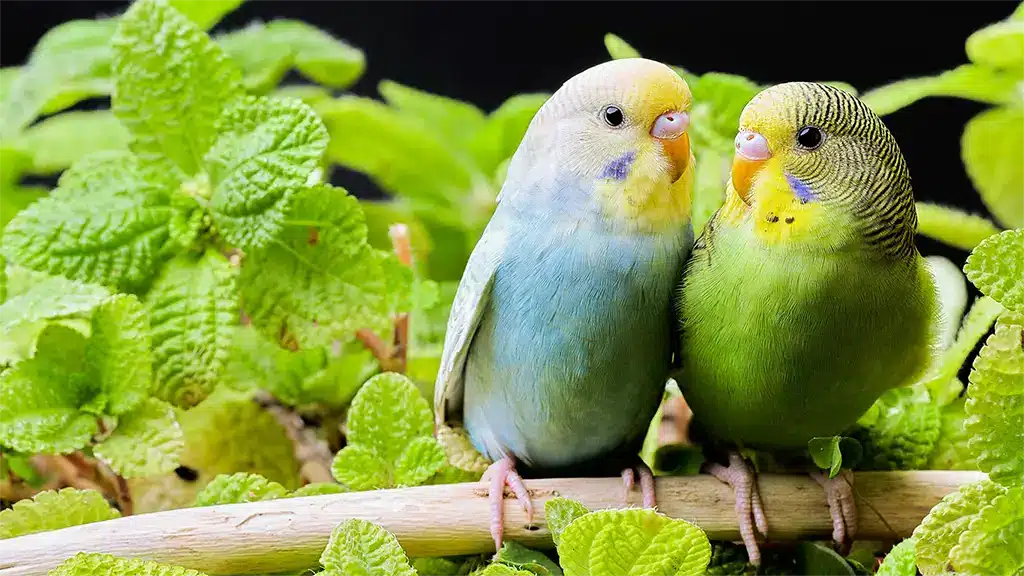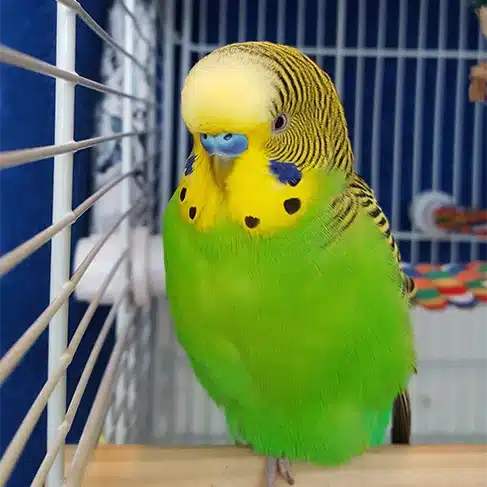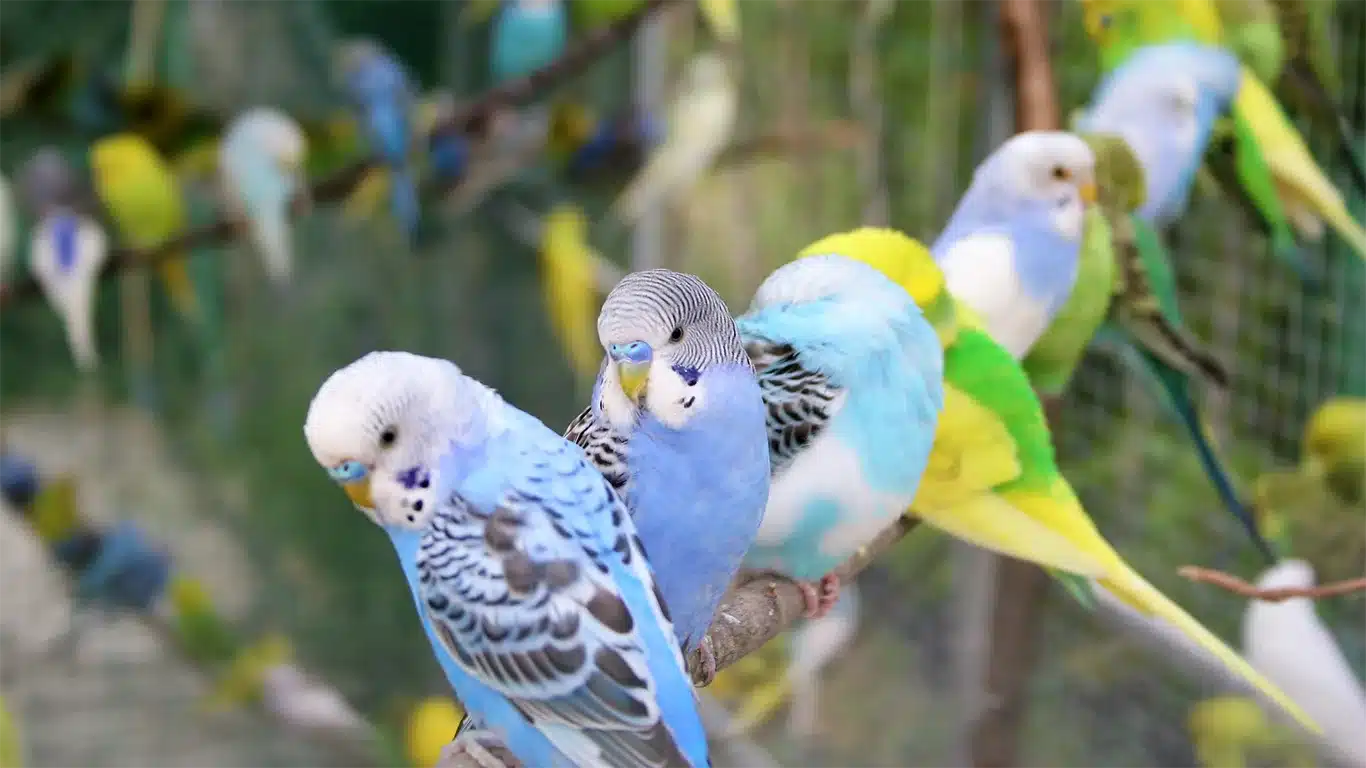If you look into budgie varieties, there are two main types that might grab your attention: the Traditional Budgerigar and the English Budgie. These two types of budgerigars are slightly different in size, color, and personality.
I will tell you everything in this article, so stay with me!
What is Budgie Variety?
Budgerigars, also known as budgies, are special pet birds with many different colors. Each variety has its own story. They originally come from Australia and have won the hearts of bird enthusiasts!
Usually, a budgerigar is a small parrot with a long tail that belongs to the Melopsittacus genus. They are very popular pets among bird lovers due to their friendly and fun behavior. Another special reason to love them is their variety of colors which attracts people a lot!
But did you know there are different types of budgies?
Yes, when we talk about Budgie Varieties, we’re mainly looking at two broad categories:
- Traditional Budgerigars
- And, English Budgies
Now you might ask, what differentiates them? Well, it’s a combination of size, plumage, and even temperament.
Australian budgies (Traditional Budgerigars) are slim, fast, have a wild charm, and act more like their wild ancestors regarding their appearance and behavior.
On the other hand, English Budgies are tamed for bird shows and as pets. They are bigger than wild budgies, full of feathers, and usually more relaxed than traditional ones.
Traditional Budgerigar from Australia
The Budgerigar, often called a budgie, comes from the wild areas of Australia. Think of the Australian outback, where tough conditions demand strong animals for survival. (Animals need to be strong to survive there)
The traditional budgie is one of them. It does well in these hard situations, showing great strength and a good ability to change.
Wild Budgerigars have light green feathers and simple black and yellow marks on their back, wings, and head. This helps them to hide among Australian plants which is a great example of how animals change to fit their environment.
English Budgie Full of Color Choices
Now let’s take a look at the English Budgie which is similar to but a bit different from the Australian Budgerigar. These birds are like living art cause each one shows a unique combination of colors and features.
But there’s a question arises that, what makes the English Budgie different?
The English Budgie is larger and more fluffy compared to the Australian one. They seem to wear fluffy coats because of their thick feathers! Their colors are like a painting filled with shades of blue, yellow, and others which makes these little birds excellent!
The Global Avian Enthusiasts Society’s study shows that English Budgies have become more popular in the last ten years, especially in Europe and North America. They are loved not only for their beautiful colors but also for their friendliness. In bird breeding, English Budgies are preferred. Breeders are always trying to create new color variations.
Exploring English Budgie Color Variations

As we explore English Budgies, their colors fall into two main groups: white-based and yellow-based. Let’s discuss these color types.
White-Based Color Varieties
- Sky Blue Budgie: This budgie comes in a light blue color that is complemented by typical budgie markings.
- Cobalt Budgie: The Cobalt Budgie boasts a richer, more deep blue color compared to its Sky Blue likeness, providing an attractive view!
- Mauve Budgie: The Mauve Budgie is a mix of blue and violet colors that make it special and beautiful among other varieties.
- Gray Budgie: The Gray Budgie has a smooth and gentle attractiveness with its beautiful colors, which range from light silver to deep charcoal.
- Violet Budgie: Violet budgies have a unique, rich violet color that makes them different from other budgie varieties. This particular type of budgie is extremely uncommon and has a high value.
- White Budgies: This variety comes in white but they might have small spots of other colors, but many are just pure white with no extra colors.
- Albino Budgie: The Albino Budgie is easily recognizable due to its white feathers and red eyes, which make it stand out in any collection.
Yellow-Based Color Varieties
- Light Green Budgie: This budgie’s plumage is a light green, similar to the fresh green of spring leaves.
- Dark Green Budgie: This variety comes in green with a dark factor. It makes the green deeper and less bright.
- Olive Budgie: The Olive Budgie’s feathers are a mix of green and brown, resulting in an olive color.
- Gray-Green Budgie: A unique combination of gray and green, this variety adds a twist to the traditional green.
- Yellow Budgie: Yellow budgies look very special. They come in mostly yellow colors with bright green patches on their undersides.
- Lutino Budgie: Similar to the Albino, but with a yellow base and red eyes, the Lutino Budgie is both unique and beautiful.
Beyond Colors: Size, Behavior, and Personality of Budgie Varieties
When you think of budgies, their bright colors often come to mind first, right?
But there’s more to these birds than looks. Budgies differ in color, size, behavior, and personality. Let’s take a closer look at these differences.
Size Matters
The Traditional Budgerigar from Australia is small in size and around 18cm to 20cm from head to tail and weighs 30 to 40 grams. These small birds can fly long distances when migrating which shows they are swift birds in their environment.
The English Budgie is different because they’re often bred for shows and as a pet. They are large and heavier compared to the wild Australian budgerigar around 25cm to 30cm from head to tail and weigh 45 to 65 grams.
It’s All in the Personality
What about their personalities? Studies, like those from the International Avian Behaviorists Association, say traditional budgies are more active and adventurous. This is probably because they need these traits to survive in the wild. English Budgies are usually more relaxed and gentle. This might be because they are bred to be pets!
Temperament
Traditional budgies are lively and curious, always moving and exploring in their environment. However, English budgies are calm and gentle. They are happy to stay close and remain peaceful. It’s like comparing an active explorer to someone who loves to relax at home!
How do colors work in Budgie’s Genetics?
Now let’s talk about something a bit more scientific but equally interesting – the genetics of budgie colors.
Genetic Mix
Budgie color genetics are like a complex, interactive palette where various genes interact to produce different colors. At the most basic level, you have two types of pigment: melanin (which gives the gray and black shades) and psittacine (responsible for red, yellow, and orange colors).
Selective Breeding
Selective breeding is important. For many years, breeders have mixed different types of budgies together to bring out certain colors. This is why we see so many bright colors today. This process is similar to a gardener who selects certain plants to crossbreed for more and better flowers.
Role of Mutation
In genetics, mutations are very important. This can change the way colors are expressed, leading to new shades and patterns. For example, a mutation in the gene that controls melanin distribution can result in a budgie with an entirely different set of markings or color intensity.
How to Choose the Right Budgie Variety?
If you’re preparing to bring a budgie into your life that’s a great decision. But with so many varieties out there, choosing the right one can be tough.
Keep in mind that selecting a budgie is not just about the color you like. Rather, there are many things to consider so that you can choose the right budgie that fits your lifestyle.
Now, let’s see how you can make this important decision.
Fitting with Your Lifestyle
Firstly, what is your daily routine like? Do you want a lively companion that keeps you busy? Or how about a more relaxed cuddly partner? If you like activity and interaction, the traditional budgie could be perfect for you. These little ones love to play and are really curious.
On the other hand, if you want a calm friend, look at English Budgie. It has a laid-back personality which could be the best choice.
Space and Environment
Consider the space you have. Larger budgie varieties like the English Budgie might need more room to spread their wings. Do you have enough space for a bigger cage and some free-flying time? Remember, a happy budgie is one with room to explore and play.
Interaction and Social Needs
Budgies are social birds and do well with regular interaction. So think about, how much time can you give to your pet. If you’re often busy, have you thought about getting two so they can be companions? It’s important to consider this so that your budgie gets the care and friendship it needs.
Care Considerations
Now, let’s talk about care. Different Budgie Varieties may have slightly different care needs. For example, the English Budgie might need more grooming and care to prevent feather issues. So, are you prepared for the extra grooming and potential vet visits?
Diet and Health
Eating a balanced diet is essential for all types of budgies. But, the larger ones (English Budgie) might eat more or need different nutrients. So are you ready to buy good quality food and supplements for them? Also, you have to take them for regular health checks with a bird specialist vet to ensure they stay healthy and happy.
Related Post: Budgie Diet: Complete Feeding Guides for Budgies.
Making the Decision
When choosing a budgie, consider more than just its appearance. Because it’s all about understanding their needs and personalities to find the right match. You can take that as making a new friend who will be part of your everyday life with a view to sharing your space and bringing happiness.
Final Words
It’s done!
I’ve extensively covered everything you need to about budgie varieties, isn’t that enough?! As we discussed above, these birds have an astonishing range of colors and patterns from deep blues to bright yellows. Each budgie has its unique fascination that makes them not just pets – they are like feathered pieces of art.
FAQs About Budgie Varieties
How many types of budgies are there?
There are two main types of budgies: the Australian Budgerigar and the English Budgie. Among these, there are numerous color mutations and variations.
What is the rarest type of budgie?
The Anthracite is the rarest budgie type. It has almost black feathers because of a very rare genetic change.
What is the most common budgie?
The most common budgie type is the wild-type or natural-color budgerigar. It is known for its bright green body and yellow head.

I’m Shajid Rahman, a happy owner of 6 beautiful budgies. I take care of this website to share tips, fun facts, and care guides about these birds.
Whether you’re a budgie lover or considering one as a pet, you’ll find helpful info here! I love these cute creatures, so I made this blog for Budgerigar fans. You can expect to get reliable information based on my years of experience. More About Me →

